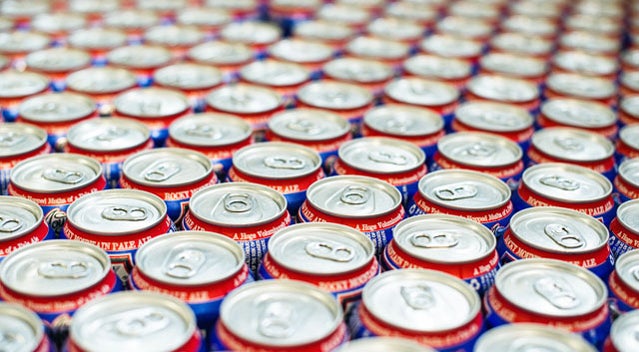
By Will McGough,
Growing
up outside of Philadelphia, it was never much of a decision. There
were no mountains to climb. We lived the city life and my upbringing was
simple: Good beer came in a bottle, crap came in a can.
Flash forward a few
years and I'm pacing the beer aisle in a store near the Front Range of the Rockies, my
fingers still greasy from prepping my bike chain. Now immersed in an arena of outdoor
activity, my priorities have changed—biking and bottles and backpacks certainly
don’t mix. Ten years ago, this would have meant inappropriately pairing a light canned
beer with a crisp, fall ride through the foliage. Today, I’m happy to say, we
finally have options. Lots of them.
Bottles
have long ruled the craft brew scene in the United States. But that's
changing, largely thanks to Dale Katechis, founder of Longmont, Colorado-based
brewery .
“I won’t call out anyone in particular, but they were all pointing and laughing at
the new kid in town,” says Katechis, recollecting the reaction he received when
he began canning his hoppy pale ale back in 2002. “They thought it was a joke,
yet today they’re all canning beer…. Talk about funny.”
That hilariously hoppy brew is Dale’s Pale Ale, a drink that has been
widely praised by beer experts and easily recognized in stores across the United States
in its red, white, and blue can. It’s true: Oskar Blues was indeed the pioneer
of the U.S. craft beer canning movement. As it approaches its 10-year
“CANniversary” in November, Osker Blues is now one of more than 220 American breweries
that have followed suit, according to .
When
it comes to gear, from backpacks to tents to bikes to shoes, weight matters. Whether
heading into the backcountry or on a leisurely day hike, no one wants to lug an
ounce more than is necessary. The same goes for adult beverage choices: cans
are lighter, smaller, and easier to pack out than bottles. So cheers for the
trend in canned craft beer.
But
we're not the only winners. Cans also offer significant environmental benefits.
Replacing glass with aluminum cuts shipping costs by a
third, according to Oskar Blues' research. Oskar
Blues fits 100 cases of canned beer on a single pallet, where it could only
put 60 cases of bottled beer. The weight of each loaded pallet is the same, but
the significantly higher volume on a pallet of cans means transportation costs
are lower, as are carbon emissions generated throughout the beer's supply
chain.
“Glass
is heavier,” says Liz Shoch, senior manager of , a non-profit that equips businesses
with the science and resources to make products more sustainable. “When
you think about that in terms of transporting the materials, it takes a lot
more fuel to ship bottles, and thus increases the amount of greenhouse gases
that result during the shipping process.”
Once
the beer is packaged and shipped, the theoretical baton representing
environmental responsibility is passed on to the consumer. Although the
recyclability of the can and bottle both hover near 100 percent, show that aluminum is more likely to be recycled in the
American household. In a 2010 study, beer and soda cans were found to be
recycled at a rate of 49.6 percent, while glass containers were recycled 33.4
percent of the time. In , the
rates were 50.7 percent for aluminum and 31.1 percent for glass.
Minal
Mistry, also a senior manager at GreenBlue, believes the extra costs associated
with the bottle will, at some point, lead the industry to begin taking the can
more seriously. “At the end of the day it’s a business,” he said, “And the
lighter materials are going to eventually win out as transportation costs
continue to increase.”
As
for the taste debate, Katechis thinks it’s only a matter of time before both
the brewer and beer drinker see that the case for the bottle is now more
brittle than ever. The old-school argument that the can alters the taste of the
beer is one of his biggest gripes—.
“Beer
is brewed and stored in metal its entire life and it never sees sunlight until
the brewer decides to put it in a bottle,” says Katechis. “Think of the can as
a mini-keg of beer. In the 10 years since we started canning, we've yet to
hear one argument for the bottle other than tradition.”
When
you start looking at the facts, it becomes obvious that both the environment
and the industry would benefit greatly from a correction of public perception.
I wonder: Given all the other environmental movements happening across America,
will consumers begin to take a stand on these issues alone? Will the fact that
the can is more portable start to make sense to people?
At
the summit of a trail in the foothills of the Rockies, I leaned
against my mountain bike and reached for a beer in my backpack. Wiping the dirt
from my bloody elbow and cracking open the still intact brew, tasting the rich,
deep flavors of the pale ale, I officially declared the can as king.